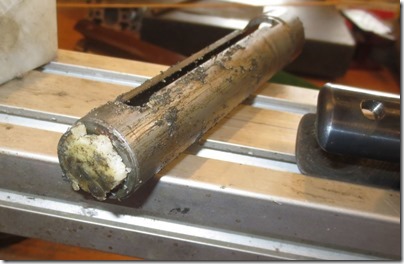
At first I thought Guy had gotten sand in the gun, but it turned out that the piston seal had completely crumbled, so that even before I got the piston out little chunks were coming out with the spring.



That’s a decomposed seal…glad it stopped shooting before it completely disintegrated.


Had to chew up the old seal to get it out, compare it to the new Maccari seal.

The new spring with spacers, compared to the old bent one. Good to replace it anyway. I didn’t do anything special, the piston seal was a little snug, but not tight so I didn’t machine or sand it. Lubed everything and put it back together. Fired 4 shots before it started to rain (Oregon winter), first one dieseled, but the last three were all 846 fps, which is amazingly steady. I’m sure it will continue to change over time as it all wears in.
Welcome back, Nick. We missed you!
ReplyDeleteGlad to see you back in action :-)
ReplyDeleteJohn-India.
So many of the sproingers from that time period had the piston seals disintegrate. A spring compressor is a must if you are to own these old gals, or at least have a friend who does.
ReplyDeleteRidgeRunner
Huge difference in the length of the old spring v.s. new. The surprising part is that the new spring is much shorter.
ReplyDeleteHow is the cocking effort of the new spring compared to the old one??
ReplyDeleteWay easier.
ReplyDeleteCan someone please offer suggestions on how to remove the impacted piston seal material at the distal end of receiver (cylinder) ??
ReplyDeleteIt's hard to comprehend how such a crumbled mess can adhere to metal so tenaciously!
Was tempted to use a long screwdriver to scrape it out but fear damaging the finish of the cylinder.
Any help on this would be greatly appreciated!
I use aluminum or brass rod with the end cut at an angle to chip it out, then I use some steel wool held on the end of a rod (I use one of those drill flap sander holders, but there are a lot of ways to do it. And rotate it a bit with a hand drill. Basically whatever works. a little oil/WD helps loosen it. That stuff ends up being baked on from the high pressure/temp.
ReplyDelete